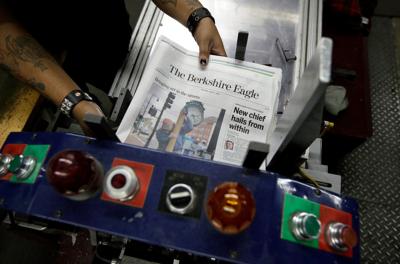PITTSFIELD — Scores of newspapers in the United States have cut days from their print publication schedules, pushed not only by pandemic-era revenue losses but by a public's embrace of all things digital.
In October, The Berkshire Eagle will join them, eliminating two days of print publication and transforming its Sunday edition into a weekend paper that will hit doorsteps and newsstands on Saturday, the company's president and publisher announced Thursday. Affiliated daily publications in Bennington and Brattleboro, Vt., will drop one day of print publication.
"For years, we have known that the future of our industry is with digital publishing, and COVID-19 has accelerated the shift to 21st century publishing, that we call Being Digital," Fredric D. Rutberg said in a letter to readers. "Being Digital means delivering the news in a way to fit the times and accommodate the future."
The Eagle will publish print editions Tuesday through Saturday, starting Oct. 6, Rutberg announced. The Bennington Banner and Brattleboro Reformer will also print editions on those five days. The papers will continue to produce Monday e-editions and focus on digital publishing seven days a week.
Since March, newspapers around the country have cut back their print schedules. Among the first was the Tampa Bay Times, which announced March 30 it would drop from seven days of print publication to two.
In Massachusetts, the Gloucester Daily Times cut Tuesday and Saturday from its schedule. Rhode Island's Narragansett Times eliminated on day of publication, according to a tally maintained by Kristen Hare of the Poynter Institute.
To the north, the Nashua, N.H., Telegraph eliminated all but Sunday print days, while the Rutland Herald and Times Argus, in Vermont, dropped from five days to three.
Dan Kennedy, a national media expert who teaches at Northeastern University, said one risk newspapers run in dropping print days is visibility.
"You need to come up with new ways of reaching people and saying, `Please buy a digital subscription,'" Kennedy said. "If you don't have that print edition that people can look at, it's hard to say, `Hey, we're here.'"
He said the pandemic sped up an existing financial squeeze on newspapers, which have seen print advertising revenues fall off even before the pandemic. For years, newspapers hoped digital ad revenues would rise to fully replace them. But new digital revenue proved a bust for many smaller media companies. "Accelerated by COVID, the bottom is dropping out of print advertising as well," Kennedy said.
As a media sage, Kennedy admits his crystal ball has been wrong. "I said 15 years ago that print would be gone by now," he said.
A new prediction: most newspapers will eventually fortify themselves behind a single Sunday or weekend edition. "And it will be digital the rest of the week. We're going to see a lot of incremental moves toward that," Kennedy said.
Kevin Moran, executive editor for New England Newspapers Inc., said the shift announced Thursday follows readers deeper into online platforms. "We're going to meet our readers where they are — and where they're headed," he said.
To Moran, the shift should be seen as good news, not bad, for fans of the publications. "Because it preserves our core product, which is the journalism," he said.
Never on Monday?
Other U.S. newspapers that cut back on print this year include those in Duluth, Minn.; Spokane, Wash.; Provo, Utah; Janesville, Wis.; and Wilkes-Barre, Pa.
In Wyoming, national media writers took note when the Casper Star-Tribune moved this summer to a Wednesday-Sunday print cycle. It meant that no daily paper produced in Wyoming comes out on Mondays, though Casper continues to create an electronic edition seven days a week.
Michelle Robinson, president of the Casper paper, said in a statement at the time the decision reflected reader preference for following news to digital formats.
"This is a shift many news organizations are making as more and more readers already consume their news online," Robinson said. "With these changes we are going to where our customers are."
Joshua Benton covered that development in Wyoming for the nonprofit Nieman Lab, which reports on media issues. "Cutting print days is, I'd argue, one of the more journalism-friendly ways to cut costs at a newspaper when revenues demand it," Benton wrote.
Benton reasoned that in addition to savings, the move encourages print subscribers to adopt use of digital delivery methods. "It can be a useful way for all of a newspaper's parts — newsroom, ad sales, circulation — to shift their attention and workflows toward the digital future," he wrote.
In an interview, Rutberg said that when the pandemic hit, advertisers closed their wallets, leading to significant revenue drops for The Eagle, as well as the Bennington Banner and Brattleboro Reformer, part of the publication group. "You have to look back to March. It just fell off the table," Rutberg said. Revenues dropped by 50 percent.
"We did some projections and it showed devastating losses going forward," Rutberg said. "So how do you manage that? We didn't want to throw quality out the window."
After stabilizing the business through use of furloughs and a Paycheck Protection Program loan, the ownership team took stock. They spoke with newspaper executives around the country, including the publisher at the Tampa Bay Times, and worked with a consultant to chart a path.
In his letter to readers, Rutberg says the moves reflect choices readers and news consumers are already making.
"Between July 2019 and July 2020, the number of digital-only subscriptions increased by 50 percent, while new print subscriptions barely made up for those that lapsed during the year," he wrote. "The choice to read a print paper is largely generational, and the number of people, like me, who prefer to read a print paper is dwindling."
Tough call
The decision to switch the weekend edition to Saturday was a tough call, Rutberg said. While it asks readers to change an ingrained habit — at least since The Eagle launched a Sunday paper in the mid-1980s — it allows an advertiser's message to stand for two days, and for the edition to be available on newsstands twice as long.
Martin Langeveld was marketing director for The Eagle when it added a Sunday edition more than 30 years ago. He went on to serve as publisher of The Eagle and is now a member of the New England Newspapers Inc. board,
Langeveld said The Eagle, like others, invested in a Sunday paper because a big new commercial player was coming to town — in this case, the Berkshire Mall.
"Suddenly you had the anchor stores advertising. That added a significant amount of revenue," he said. The Eagle's Sunday edition eventually grew to a circulation high of about 35,000.
Even so, Langeveld came to believe existing print schedules could not be sustained. He wrote more than a decade ago, in commentaries for the trade press, about the wisdom of paring back. "I was kind of a voice crying in the wilderness," he said.
Langeveld said he supports the decision to combine into a single weekend edition that appears Saturday. "The time had finally come to do these things. A weekend edition just makes more sense," he said.
The Eagle's announcement comes five months after the Daily Journal, a roughly 10,000-circulation, family-owned newspaper in Marietta, Ga., made the same change, dropping two editions and publishing in print Tuesday through Saturday.
"I guess in a perfect world we wouldn't do this," Otis Brumby III, the paper's publisher, said in a telephone interview Thursday. "But it's not been as big an issue as I thought it might be. It's going very well."
Brumby said readers have been understanding, though some asked why the subscription price was not cut as well. He said the paper's staff is working to build up its digital presence and will be creating an electronic edition to distribute Sunday and Mondays.
"It's difficult because you're used to putting out a daily paper," he said of the shift.
Rutberg said publishers who had opted to reduce print publication days advised him to be open and honest about what lies ahead.
"I look upon the trust that our community has in us as our most valuable asset," he said. "I think people will give us the benefit of the doubt."
Larry Parnass can be reached at lparnass@berkshireeagle.com, at @larryparnass on Twitter and 413-588-8341.


